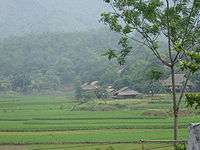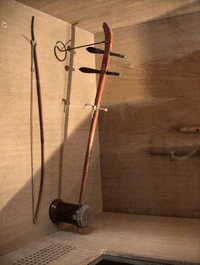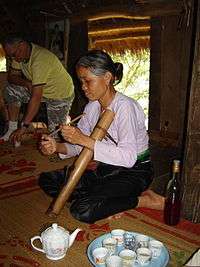Muong people
| Total population | |
|---|---|
| c. 1.3 million | |
| Regions with significant populations | |
| 1,268,963 (2009)[1] | |
| Languages | |
| Muong | |
| Religion | |
| Animism, Buddhism, Christianity (Vietnamese Hoà Ban Cathòlič sect of Catholic Church) | |


The Mường (Vietnamese: người Mường) is an ethnic group native to Vietnam; it is the country's third largest of 53 minority groups, with an estimated population of 1.26 million (based on the 2009 census and five years of population growth). The Muong people inhabit the mountainous region of northern Vietnam, concentrated in Hòa Bình Province and the mountainous districts of Thanh Hóa Province. They are most closely related to the ethnic Vietnamese (Kinh). The term "muong" of Thai origin means "district, region". To emphasize their difference from the inhabitants of the valleys and highlanders, Muong call themselves "monglong", which means "people living in the center".
While the Muong are believed to be related to the Vietnamese, ethnologists have theorized that the Muong and Kinh (ethnic Vietnamese) separation happened when the proto-Vietnamese became heavily Sinicised, beginning from the 111 BC invasion by Chinese Emperor Wu of Han, while the Muong, living in the mountains, developed independently. The Muong and the Tai have had a mutual influence on each other's culture, so today the Muong are ethnically and linguistically close to the Vietnamese, but culturally and socially similar to the Tai.
Language
The Muong speak the Muong language, a close relative of Vietnamese. Writing on the basis of the Vietnamese alphabet appeared in the 20th century, but among the Muong aristocracy were people who studied Confucian canons and Chinese hieroglyphics.
Muong language is mainly used in the domestic sphere of communication. Most of the native speakers of this language speak also Vietnamese.
Geographic distribution
The Muonges live in the north of Vietnam, mainly in the mountainous provinces of Hoa Binh and Thanh Hoa. Around the city of Hoa Binh there are four large population centers, in which the Muong people live: Muonguang, Muongbi, Muongthang and Muongdong. Mainly, the Muonges settle in this area along streams and rivers.
Literature
Muong have many valuable epics (Muong language: mo), such as Te tấc te đác (meaning: Giving birth to the Earth and the Water).
Holidays
Main holidays of muong are New Year and agrarian holidays. During the celebration of the New Year, Muong people are pray to the ancestors. Such prayers are also arranged on the days of revolutionary holidays, after which the whole village is treat themselves to pre-cooked dishes.
Religion
Mainly, the Muonges profess Buddhism and Christianity (Catholics), but in their beliefs are also represented animistic views. They believe in the existence of harmful spirits (ma tai, ma em, and others). The sorcerers used fear of spirits against people who did not suit them, declaring them carriers of the spirit ma tai. Deceived peasants beat and sometimes killed innocent people.
The New Life
After the August Revolution the way of life of Muong people have changed, the large family gave way to a small one. Married brothers no longer live with their parents, but in separate families.
The peasants received community allotments of 1 to 3 Mau per family, industry began to develop. Most villages have primary schools
See also
References
- ↑ "The 2009 Vietnam Population and Housing Census: Completed Results". General Statistics Office of Vietnam: Central Population and Housing Census Steering Committee. June 2010. p. 134. Retrieved 26 November 2013.
External links
| Wikimedia Commons has media related to Muong people. |
